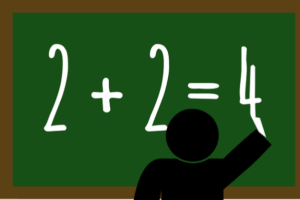7.2 Three Types of Conditionals
This module provides practice using Venn Diagrams to verify rules of inference, and applying the rules for Categorical Syllogism. It also introduces the Quantifier Negation law.
Table of Contents
- 7.2 Three Types of Conditionals
7.2.1 Antecedents and Consequents

If the antecedent is true, then the consequent must follow.
IF_THEN
A conditional is a type of sentence relating two different propositions. Conditionals are divided into two parts: an antecedent (if) and a consequent (then). In a conditional, the truth of the consequent is typically supposed to depend in some way on the truth of the antecedent. In English, conditionals are usually expressed with words like IF and THEN. For instance, this is a conditional:
(1) If the dog is out of the house, then the dog is muddy.
“The dog is out of the house” is antecedent of the conditional, and “the dog is muddy” is the consequent.
When phrased in this IF_THEN format, the antecedent comes first, and the consequent comes second; however, sometimes when speaking we put the antecedent last and the consequent first. For example, suppose that I really want to see a movie that is coming out, and I’m just looking for an excuse to go to the movie. If you tell me you’re going, then I’m definitely coming along.
(2) I will go to the movie if you go to the movie.
Here, “You go to the movie” is the antecedent, and “I will go to the movie” is the consequent. We might rephrase it this way:
(2*) If you are going to the movie, then I am going to the movie.
Notice that this sentence is not saying that the only situation where I will go to the movie is one in which you go to the movie. Suppose that you don’t go to the movie, but I still go to the movie. Well, sentence (2) is still true. It’s true because I didn’t say that I wouldn’t go to the movie if you didn’t go — I just said that I would go to the movie if you did go. For it to be false, it would have to be the case that you went to the movie, but I didn’t go to the movie.
On the other hand, sometimes we use the phrase in English, “only if”. We say that one thing will happen only if another thing happens. Despite appearances, the phrase “only if” works like the word “then”: it indicates that what follows it is the consequent. For instance, suppose that I don’t like baseball, and I won’t even start to consider playing it unless you’re going to be on the team — although even knowing that won’t guarantee that I’ll play.
(3) I will play baseball only if you play baseball.
Here, I am saying that the only situation where I will play baseball is one in which you play baseball. If you aren’t playing baseball, then I’m not playing baseball. This sentence would be false if you were to quit baseball, but I kept playing. Notice, however, that the sentence would still be true if you were to play baseball, but I didn’t play baseball. I haven’t promised that I will play baseball if you play it. I’ve only promised that I won’t play baseball if you don’t play it. We might rephrase it this way:
(3*) If I am playing baseball, then you are playing baseball.
Three Types of Conditionals
Conditionals come in three different categories:
Material conditionals are the the simplest, because they relate facts in our world to other facts in our world.
Counterfactual conditionals are more complex, because they relate facts in our world to facts in nearby possible worlds: other ways the world could have been that are similar to our world, but not the same as it.
Strict conditionals are the most complex, because they relate facts between all other possible worlds, irrespective of the way our world actually is.
In the next few pages, we will discuss each type of conditional sentence.
7.2.2 Material Conditionals

If one light in a strand lights up, then the next one lights up.
Material Conditionals
Let’s start with the simplest kind of conditional.
A material conditional is FALSE whenever:
The antecedent is TRUE, but the consequent is FALSE.
A material conditional is thus TRUE whenever either:
The antecedent is FALSE, or else
The consequent is TRUE
For example, suppose I say this:
(5) If I forgot my wallet, then I do not have any money on me.
A counterexample is a possible situation in which a statement is false. What would be a counterexample to this claim? A counterexample would look like this:
(~5) In fact, I forgot my wallet, but I do have money on me. (I keep cash in my shoes)
If (~5) is true, then (5) is false. On the other hand, what would make (5) true? Well, here’s three scenarios where (5) would be true.
+ In fact I forgot my wallet, and I do not have any money on me.
+ In fact I didn’t forget my wallet and I do have money on me.
+ In fact I didn’t forget my wallet, but I still don’t have money on me (my wallet is empty).
Here’s another claim. Suppose I say:
(6) If Lily the dog ate wheat thins, then she is itching.
What would a counterexample to this claim be? The antecedent must be true, but the consequent false. For instance, this would make (6) false:
(~6) In fact, Lily the dog ate wheat thins, but she is not itching.
What would make (6) true? There are several options:
+ In fact, Lily the dog ate wheat thins, and she is itching.
+ In fact, Lily the dog did not eat wheat thins, and she is not itching.
+ In fact, Lily the dog did not eat wheat thins, but she is still itching.
Truth Tables for Material Conditionals
We can symbolize a material conditional using the arrow symbol, → , where “if P then Q” is written P → Q. The truth table for a material conditional is true in every row except for one: it is false with the antecedent is true but the consequent is false. For simplicity for students using simple keyboards, we will type => to represent this arrow.
| P | Q | P => Q |
| T | T | T |
| T | F | F |
| F | T | T |
| F | F | T |
No Causal Connection
Notice that according to the truth table there is no causal connection represented between P and Q. Although we may think of the ‘arrow’ symbol as representing causation or order of explanation, in logic it only represents the relationship in the truth table above: the conditional is true whenever P is false, and whenever Q is true. If you are tempted to think of “If P then Q” as meaning that P causes or explains Q, think about true material conditionals like, “If the moon is made of cheese, then I am a monkey’s uncle.” The sentence is true, because both the antecedent and consequent are false, even though there is no relationship between them. Or, consider the sentence, “If fire hydrants are yellow, then Ohio is a State.” The sentence is true, because the consequent is true (Ohio is a State), even though there is no connection between the two.
Why Focus on Material Conditionals
In the next few pages, we’ll discuss two more complex types of conditionals: counterfactual conditionals, and strict conditionals. Many of the sentences we say in everyday English that use an “If…Then” structure are actually strict conditionals or counterfactual conditionals. It is very complicated, however, to model the truth conditions for these two types of conditionals in any methodical and formal way: this is a topic usually studied only in advanced undergraduate or graduate-level logic courses. The truth conditions of the material conditional, on the other hand, can be modeled using a tool that is easy to use and already familiar to us: the truth table. We say that material conditionals are truth functional, unlike other conditionals, meaning that we can model their possible truth values using a truth table. Many of the most useful rules of inference we’ll study apply to material conditionals. So, this is why we will focus on them in future modules.
7.2.3 Counterfactual Conditionals

If the egg were dropped, then what would happen?
Counterfactuals
Counterfactual conditionals are the most common type of conditional in English. We use them when we want to speculate about what would have happened if something else hadn’t happened, or what would happen if something else were to occur. They are called counterfactuals because they require us to look beyond the facts in our world and try to figure out how things most likely would have occurred if something else had gone differently. They have the form:
IF P WERE TRUE, THEN Q WOULD PROBABLY BE TRUE
For example, what do you think would happen if I put a cube of sugar in a cup of boiling water?
Most likely:
(7) If you were to put a cube of sugar in a cup of boiling water, then the cube would dissolve in the water.
This is a counterfactual, because I haven’t actually put the cube of sugar in a cup of boiling water. Instead, it’s saying something like this: consider the scenario most similar to our actual world, where there’s a cup of boiling water and I put the sugar in the cup. In that scenario, the cube would dissolve in the water.
A counterfactual is true if indeed the scenario we are considering is the nearest or most “realistic” scenario. For instance, there’s a possible scenario in which I put the sugar in the cup, but the sugar doesn’t dissolve. Instead, it turns blue and starts glowing. This is technically possible — it might happen in a movie — but it’s highly unlikely. It’s not a realistic possibility.
Of course, it’s hard to judge in a lot of cases what is most realistic. We can’t actually observe what doesn’t happen. The more scientific knowledge we gain, the better we’re able to judge counterfactuals, but many things — like human behavior — are still hard to predict.
For example, what do you think would happen if everyone in the class failed a quiz?
You might think this is true:
(8) If everyone in the class failed the test, the professor would curve grades upward.
But this depends on the temperament of the professor. Instead, this could be the case:
(8*) If everyone in the class failed the test, the professor would fail everyone.
Or perhaps this would happen:
(8**) If everyone in the class failed the test, the professor would offer everyone a retake.
The important thing to notice is that all of these outcomes are possible, but which one you think is more realistic depends on a lot of factors which are hard to know. We’d want to gather evidence like what the professor had done in the past, or what personality the professor had, or what the professor stated he would do.
Counterfactual conditionals are useful for representing causal relationships or types of explanations, a topic we will return to near the end the class. Because counterfactual conditionals are not truth functional and can’t be modeled using a truth table, we won’t focus on them for most of the class, however.
7.2.4 Strict Conditionals

Necessarily, if you have two and two, then you have four.
Possible Worlds and Contradictions
Many of the ideas in logic are easiest to think about when we speak in terms of logically possible worlds. Although the idea of an ‘alternate reality’ or ‘other possible world’ has entered the popular imagination through books and movies, and before that through developments in Physics over the last hundred years, the idea of a “possible world” actually goes back to the philosopher Gottfried Leibniz (1646-1716).
For Leibniz, a possible world is a complete set of possible facts that could have been the case, regardless of whether or not it is actually the case. For every proposition, a possible world says whether the proposition is true or false in that world. For every set of propositions which are not contradictory, there is at least one possible world where those propositions are true.
By contrast, the word actually is used to refer to the actual world: our world, the real world around us, the actual facts. For instance, in the actual world there are no unicorns, but in another possible world there are unicorns. In the actual world, the sun is hot, but in another possible world, the sun is cold.
We define what is and isn’t “possible” in terms of what is or isn’t contradictory.
A contradiction is the conjunction of a proposition with its negation.
A contradiction has the form P AND NOT P (i.e., P & ~P). For example, “Jeff has two feet and Jeff does not have two feet” is a contradiction. Because a proposition is true whenever its negation is false, and false whenever its negation is true, the conjunction of a proposition with its negation can never be true. Hence:
A contradiction cannot possibly be true.
We can prove this with a truth table:
| P | ~P | P & ~P |
| T | F | F |
| F | T | F |
Because P & ~P is false in every row, it can’t possibly be true.
Notice that some claims might seem at odds with each other or in conflict with each other, but they are not strictly contradictory. For instance, the claim “It is morning” seems to be in conflict with the claim “It is dark outside”, but this isn’t a strict contradiction: it could be dark outside and yet morning. Similarly, the claim “Ginny is a living human being” seems to be in conflict with “Ginny never eats food or drinks water”, but while there might be a biological impossibility here, there is no strict contradiction, and so this is not a logical impossibility: there could have existed such a being as Ginny, in some other possible world.
This gives us definitions of logical possibility, logical impossibility, logical necessity, and logical contingency:
Anything which is not contradictory is logically possible.
Anything which is contradictory is logically impossible.
If it is logically impossible for P to be false, then P is logically necessary.
Anything which is logically possible, but not logically necessary, is logically contingent.
The reason for saying “logically possible” or “logically impossible” as opposed to just “possible” or “impossible” is that in everyday speech, we make a lot of assumptions about the world. When we say that something is “impossible”, or that it “can’t happen”, we mean that it contradicts certain beliefs or assumptions we have about the world, or that it contradicts what we know to be true about the world. For instance, we’d ordinarily say it is “impossible” for a human being to fly simply by flapping their arms vigorously. What we mean is that this scenario contradicts what we know about the laws of nature or the laws of physics. But it isn’t a strict contradiction: “A human flies by flapping his arms” does not have the structure “P and not P”. So, in the broadest sense of “possible”, it is logically possible that the laws of physics could have been different, and so it is logically possible that a human could fly in this way. There is another possible world in which humans fly in this way.
A good (but imperfect) intuitive guide to whether something could be true in another possible world is to see whether or not you can imagine a movie in which the thing is true. I can imagine a movie in which people fly by flapping their arms, but I can’t imagine a movie in which people are not people. I can imagine a movie in which unicorns rule the earth, but I can’t imagine a movie in which unicorns have two horns (they wouldn’t be unicorns anymore). I can imagine a movie in which circles talk, but I can’t imagine a movie in which circles are squares. Typically the reason I can’t imagine something is that it is contradictory, and the reason I can imagine something is that it isn’t contradictory — it is logically possible. There are exceptions (possibilities I can’t imagine and impossibilities I can imagine) but for our purposes this will generally be a good rule of thumb.
Strict Conditionals
Now that we have a definition of “logically possible” and “logically necessary”, we can talk about strict conditionals. Strict the conditionals have the form:
IF P WERE TRUE, THEN Q WOULD HAVE TO BE TRUE
In a strict conditional, if the antecedent is true, then it is logically necessary that the consequent is true. We might say that the consequent “logically follows from” the antecedent, or that the antecedent “logically entails” the consequent. The idea is that there’s simply no way the consequent could fail to be true, so long as the antecedent is true. The truth of the antecedent guarantees the truth of the consequent.
A strict conditional is TRUE if:
every possible world in which the antecedent is true is a world in which the consequent is also true.
A strict conditional is FALSE if:
there is some possible world where the antecedent is true, but the consequent is false.
Some examples of true strict conditionals:
- If someone is 20 years old, then they must be more than 10 years old.
(In every possible world, 20 is greater than 10)
- If Sam is as tall as Isaac, and Isaac is as tall as Abe, then Sam must be as tall as Abe.
(In every possible world, if A=B and B=C, then A=C)
- If the Pentagon building is truly a pentagon, then the Pentagon building has to have exactly five sides.
(There are possible worlds in which the Pentagon building doesn’t exist, and possible worlds in which the Pentagon building was mistakenly built with 6 or 7 sides. But in every possible world in which the Pentagon building truly has a pentagon shape, it has 5 sides).
On the other hand, the following would be false strict conditionals:
- If someone is late to a job interview, then they simply can’t get the job.
(There is a possible world in which someone is late to a job interview, but still gets the job).
- If you were born, then you must have had two biological parents.
(There is a possible world in which reproduction requires only one biological parent, or requires a committee of fifteen biological parents).
- If someone loves you, then you must love them back.
(There is a possible world — namely, the actual world — in which people don’t always love back those who love them)
Notice that claims about definitions are typically strict conditionals. For instance:
- If Lily is a dog, then Lily is a mammal.
- If Jason is a bachelor, then Jason is unmarried.
There is a possible world in which Lily doesn’t exist, and there is a possible world in which Jason exists but is married. If you don’t know who I’m referring to by “Lily” or “Jason”, you don’t even know whether Lily is actually an existing dog or whether Jason actually exists and is a bachelor. But what you do know is that every possible world in which Lily is a dog is a possible world in which she is a mammal: because the definition of a dog is that a dog is a mammal of a certain type. You know that every possible world in which Jason is a bachelor is one in which he is unmarried, because the definition of a bachelor requires that all bachelors be unmarried and male.
Definitional claims are typically divided into necessary conditions and sufficient conditions. In a necessary condition, everything which is an instance of the thing being defined must fall into the category which is a necessary condition. For instance, suppose you are defining the word “dog” or “bachelor”, like we are doing above. It is a necessary condition of being a dog that all dogs are mammals. It is a necessary condition of being a bachelor that all bachelors are unmarried. We can phrase a necessary condition with this strict conditional:
If something qualifies as a “dog”, then it must be a mammal.
If something qualifies as a “bachelor”, then it must be unmarried.
Of course, there’s more to being a dog than being a mammal: cats are mammals also, but cats aren’t dogs. And there’s more to being a bachelor than being unmarried: an unmarried woman is a bachelorette, not a bachelor. So, the claims above aren’t complete definitions, they only give necessary conditions.
The reverse kind of definitional claim is called a sufficient condition, where anything which falls into the category which is a sufficient condition must be an instance of the thing being defined. For example, it is sufficient for something to be a dog if it is a Shih-tzu, a Spaniel, or a Terrier. Everything which falls into the category “Spaniel” has to be a dog. Likewise, it is sufficient for someone to be a bachelor if he is a man who has never married and is eligible for marriage. We can phrase these as strict conditionals:
If something is a Spaniel, then it must qualify as a “dog”
If someone has never married, but is eligible for marriage and a man, then he must qualify as a “bachelor”.
Summary
Let’s summarize what we’ve talked about so far.
- All conditionals are composed of an antecedent (IF…) and a consequent (THEN…).
- There are three types of conditionals: material conditionals, counterfactual conditionals, and strict conditionals.
- Material conditionals are made true or false by the actual world: they’re false only in the situation where the antecedent is actually true, and the consequent is actually false.
- Counterfactual conditionals are made true or false by the nearest possible world where the antecedent is true. They’re true if the consequent would have been true in the nearest possible world where the antecedent is true.
- “Possible worlds” are non-contradictory situations that could have been, in a world very different from our own. Something is “logically possible” if it occurs in some possible worlds, “logically contingent” if it occurs in some but not all, “logically impossible” if it occurs in none (because it is a contradiction), and “logically necessary” if it occurs in all (because it would be a contradiction for it to be false).
- Strict conditionals are made true or false by what’s true in all of the possible worlds where the antecedent is true. They are false if there is even one possible world where the antecedent is true, but the consequent is false.
- Definitional claims are typically expressed as strict conditionals.
7.2.5 Biconditionals

A two-way pact is a kind of biconditional agreement.
Biconditionals
Sometimes both parts of a conditional depend on each other. The conditional “goes both ways”. We call this a biconditional, and we state it using the words “if and only if”. For example, suppose you and I form a pact to mutually give money to a charity.
(4) I donate to charity if and only if you donate to charity.
This sentence is making two distinct claims.
First, it is claiming that: (4a) I donate to charity if you donate to charity.
Which means: (4a*) If you donate to charity, then I donate to charity.
Second, it is claiming that: (4b) I donate to charity only if you donate to charity.
Which means: (4b*) If I donate to charity, then you donate to charity.
So, a biconditional is a conjunction of two conditionals:
(4*) If you donate to charity, then I donate to charity AND If I donate to charity, then you donate to charity.
Truth Tables for Material Biconditionals
We will use the double-arrow <=> to represent a material conditional. The truth table for material biconditionals looks like this:
| P | Q | P <=> Q |
| T | T | T |
| T | F | F |
| F | T | F |
| F | F | T |
The biconditional is true whenever the truth value of P and Q matches: whenever both P and Q are T, or both P and Q are F. The biconditional is false whenever the truth value of P and Q does not match: whenever one is true and not the other.
Strict Biconditionals and Logical Equivalence
Previously we used the triple bar symbol ≡ to represent logical equivalence. We wrote “P ≡ Q” when the P and Q column have the same truth value in every row of a truth table. Logical equivalence is the relationship of a strict biconditional: two sentences are logically equivalent if a material biconditional between them would be true on every row of the truth table.
For example, we know from DeMorgan’s Law that:
~(P & Q) ≡ ~Q v ~P
~(P v Q) ≡ ~P & ~Q
This means the same thing as:
Necessarily, if ~(P & Q), then ~Q v ~P, and if ~Q v ~P, then ~(P & Q)
Necessarily, if ~(P v Q) then ~P & ~Q, and if ~P & ~Q, then ~(P v Q)
Most other textbooks use the ≡ symbol to represent the material biconditional, and ⇔ to represent the strict biconditional. We’re using <=> to represent the material biconditional to make things simpler for students with basic keyboards, and so ≡ is used in this class for the strict biconditional instead.
Submodule 7.2 Quiz
Licenses and Attributions
Key Sources:
- Watson, Jeffrey (2019). Introduction to Logic. Licensed under: (CC BY-SA).
Next Page: 8.1 Symbolizing Material Conditionals
